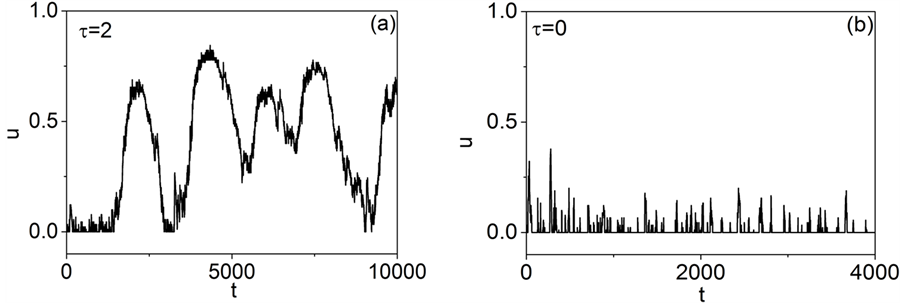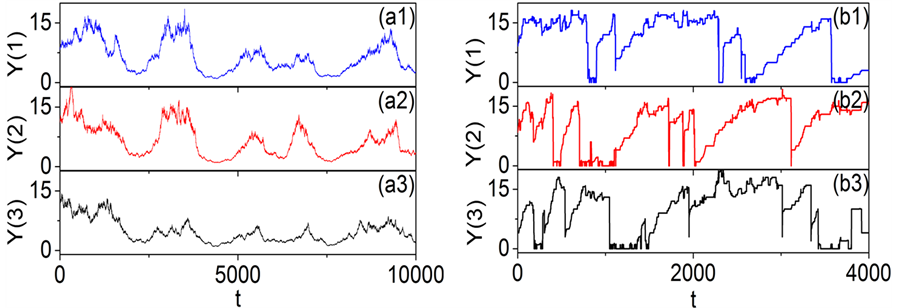1. 引言
同步是一种广泛存在于自然界中的现象 [1] ,例如,人脑的神经元刺激 [2] ,心脏起搏器的同步 [3] ,萤火虫的集体发光效应 [4] ,剧院里的掌声 [5] ,以及激光器间的耦合 [6] 等等。对于此类同步现象产生的原因以及它的物理机制,科学家们已经探索了数十年,并且有了很大的进展。尤其是对于宏观经济系统而言,同步的现象更是引起了广泛的关注 [7] 。
从1960年开始,Winfree [8] 就已经研究了存在弱耦合相互作用的振子系统,在相互作用的关系中寻找同步产生的物理机制,他通过研究带有耦合的大数量振子的系统发现同步类似于热力学系统 [9] 中的相变 [10] ,振子间的耦合强度一旦超过某个临界值(阈值),就会产生同步,并且随着耦合强度的不断增加,越来越多的振子会继续同步直至达到全局同步 [8] 。
近年来,越来越多的学者开始研究其他系统的同步原理,尤其是对于宏观经济系统,越来越多的模型被提出。这些模型大多都是为了研究系统中出现的“危机波”现象 [7] ,这种“危机波”就是一种典型的同步现象,因为传统的相变理论无法解释此类现象产生的原因,因为模型中没有任何一个参量能够类比成耦合强度或是其他能够代表个体间相互作用的大小的量。
本文研究了宏观经济模型中同步现象产生的原因。当模型引入时间延迟后,我们并不知道此类“危机波”是如何被影响的,但是我们发现,并不是任意的时间延迟都可以诱发同步,只有恰当的时间延迟才能引发同步,时间延迟是通过更新策略中市场需求的时间来定义的,因为在实际生产生活中,信息的搜集是耗时的,所以市场需求的确定是需要一定的时间的,而时间延迟的加入导致更新策略使用的信息是延迟的,此时时间延迟的加入就使得更新策略的效果降低,正是这种策略的无效性导致了系统出现了类似“危机波”的同步现象。文章的第一部分是模型的简介,第二部分是同步现象的数值模拟结果,最后一部分就是本文所得到的结论以及它的应用。
2. 模型
宏观经济的人基代理模型“MARK I”是由Delli Gatti及其合作者提出 [11] [12] ,这样一个模型是剔除了一些细节之后仍能代表真实系统的模型,它主要包含三个对象,工厂( )、住户(
)、住户( )和一个银行,工厂生产一定的产品然后卖出,生产的产品的数量
)和一个银行,工厂生产一定的产品然后卖出,生产的产品的数量 是由市场的需求
是由市场的需求 决定的,市场的需求是根据上一个时间步市场卖出的产品决定的,工厂生产产品需要雇佣一定的员工,雇佣的员工的数量
决定的,市场的需求是根据上一个时间步市场卖出的产品决定的,工厂生产产品需要雇佣一定的员工,雇佣的员工的数量 是由需要生产的产品的数量决定,需要生产的产品越多,雇佣的员工数量也就越多,雇佣的员工数与生产的产品数是存在一定的比例关系的。工厂雇佣员工需要支付员工薪水
是由需要生产的产品的数量决定,需要生产的产品越多,雇佣的员工数量也就越多,雇佣的员工数与生产的产品数是存在一定的比例关系的。工厂雇佣员工需要支付员工薪水 ,这个薪水此模型中是固定的(薪水值为1),产出一定的产品之后,需要在市场上一定价格
,这个薪水此模型中是固定的(薪水值为1),产出一定的产品之后,需要在市场上一定价格 卖出,产品的价格与时间和工厂无关,价格遵循一定的规则,见等式(2)。
卖出,产品的价格与时间和工厂无关,价格遵循一定的规则,见等式(2)。
当工厂销售产品的利润不足以支付工人的薪水时,它就需要向银行申请贷款,银行提供一定利率的贷款,而这个贷款利率是和基准利率以及工厂的金融脆弱性相关的。住户通过工作获得一定的薪水,在市场中花费一定比例的积蓄购买产品,他们随机选择M家工厂购买,按价格优先原则,优先购买价格低的工厂的产品。
失业率是表征该模型总的经济形势的一个值,
 (1)
(1)
失业率越小表示该模型的经济状况越好,更新策略在这个模型中是非常重要的一个规则,它决定着工厂的产量和价格,并对整个市场的失业率有着重要的影响,本文,我们将时间延迟引入到更新策略中,也就是说,市场需求的获取是需要一定的时间长度的,正是这样的时间长度的存在导致了宏观经济系统中同步的产生。
 (2)
(2)
其中的 是工厂
是工厂 的市场需求,但它的获取有一定的时间延迟,这个需要获取信息的时间长度就是
的市场需求,但它的获取有一定的时间延迟,这个需要获取信息的时间长度就是 ,
, 是目标产量,
是目标产量, 是[0,1]间的随机变量,与工厂和时间不相干;
是[0,1]间的随机变量,与工厂和时间不相干; 和
和 是[0,1]间的参数。
是[0,1]间的参数。
 (3)
(3)
是t时刻商品的平均价格。
公式(2)中的四条规则可以理解为工厂的一种自适应的策略博弈,工厂会依据上个时间步的供需关系和价格水平对这一步的价格和产量进行相应调整。前两条对应工厂i的产量和市场需求量相等的情况,即生产的产品能全部被卖出,如果定价高于均价,那么该工厂将增加目标产量;如果定价低于均价,则该工厂将提高定价。后两条对应工厂i的产量大于市场需求的情况,即供大于求,如果定价小于均价,那么该工厂将减少目标产量;如果定价大于均价则降价。
3. 数值模拟
本文将上述模型使用计算机语言进行编程,模拟出该模型并对它进行数值计算,研究该系统中的经济状况,并观察同步“危机波”产生的原因。能够表征经济状况的参数有很多,此处我们选取最具代表性的参数值,失业率;失业率是最能反映宏观经济系统经济状态的值。
图1(b)是没有时间延迟的系统的失业率情况,也就是 ,此时更新策略所使用的信息都是及时的,更新策略的效果很好,图中显示失业率一直处在比较小的位置,接近于0,表示几乎所有的住户都有工作,一方面,有的工厂一直都处在良好的生产经营状态中,一直都需要足够数量的员工生产产品,并且生产的产品都能卖得出去;另一方面,有的工厂因为经营不善导致破产,解雇了员工,但是因为一个工厂的破产并不会对其他的工厂造成影响,这些被解雇的员工可以重新被其他经营状况良好的工厂雇佣,所以,在没有时间延迟的情况下,系统的失业率一直很低。
,此时更新策略所使用的信息都是及时的,更新策略的效果很好,图中显示失业率一直处在比较小的位置,接近于0,表示几乎所有的住户都有工作,一方面,有的工厂一直都处在良好的生产经营状态中,一直都需要足够数量的员工生产产品,并且生产的产品都能卖得出去;另一方面,有的工厂因为经营不善导致破产,解雇了员工,但是因为一个工厂的破产并不会对其他的工厂造成影响,这些被解雇的员工可以重新被其他经营状况良好的工厂雇佣,所以,在没有时间延迟的情况下,系统的失业率一直很低。
图1(a)则是加入时间延迟后的系统的失业状况,此时 ,由图可见,失业率出现了大的波动,这个波动就叫做“危机波”,这种波动就是经济系统中典型的同步现象,由于时间延迟的存在,使得更新策略使用的信息并不及时准确,更新策略的效果降低,那么工厂无法及时的根据策略调整生产计划,工厂之间的个体差异性就会减小,相互作用变强,也就出现了同步现象。
,由图可见,失业率出现了大的波动,这个波动就叫做“危机波”,这种波动就是经济系统中典型的同步现象,由于时间延迟的存在,使得更新策略使用的信息并不及时准确,更新策略的效果降低,那么工厂无法及时的根据策略调整生产计划,工厂之间的个体差异性就会减小,相互作用变强,也就出现了同步现象。
失业率是表征系统总的经济状况的,而图2我们选择单个工厂的产量来研究单个个体的情况。图2是随机选择三个工厂的产量变化,和图1的参数条件完全相同,b1-3的时间延迟为0,由图可见,三个工厂间的产量并没有什么特别的关联,各自生产也有各自破产,并且一个工厂的破产并不会引起其它工厂的连续破产,工厂之间的个体差异性大。没有时间延迟的加入,就意味着工厂所使用的更新策略效果非常的好,工厂间的相互作用较弱,就会导致工厂间并没有什么特别大的关联,不会出现同步现象。
图2(a1)-(a3)则出现了不同的现象,从图可以明显的看出,三个工厂的产量起伏基本一致,也就是他们生产是几乎一致的,加入了时间延迟后的更新策略效果减弱,这就导致工厂间的差异性减小,相互作用增强,从而出现了图上所显示的同步现象。
4. 结论
研究发现,时间延迟的加入使得宏观经济系统出现同步现象,这种同步现象也可以称作“危机波”,

Figure 1. Typical time trajectories of the unemployment rate u in the macroeconomic agent-based model for τ = 2 (a) and τ = 0 (b)
图1. 不同的时间延迟下,系统失业率随着时间的变化,τ = 2 (a) 和τ = 0 (b)
 (a) (b)
(a) (b)
Figure 2. Typical time trajectories of the production Y of 3 random selected firms in the macroeconomic agent-based model for τ = 2 (a) and τ = 0 (b)
图2. 不同时间延迟下,随机选择三个工厂的产量随时间的变化,τ = 2 (a) 和τ = 0 (b)
显然,同步现象的产生和时间延迟有着必然的关系,时间延迟的加入使得更新策略使用的信息过时,从而弱化了更新策略的效果,也就产生了同步现象。这种机制和以往的足够大的耦合强度导致的同步机制并不相同,本文研究的模型中并没有直接代表相互作用大小的类似耦合强度的参量,也不能通过相变理论来解释,换言之,加入时间延迟的更新策略更算是一种博弈策略,工厂之间相互博弈,从而出现集体失业的集体行为,也就是同步。这种现象类似于生态系统中的自然选择,自然选择的过程也是一种博弈,优胜劣汰,从而达到最佳状态。
基金项目
本文的研究得到江苏省普通高校自然科学研究项目(项目编号:15KJB140007)的资助。